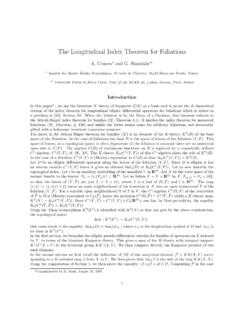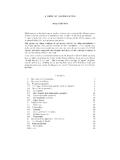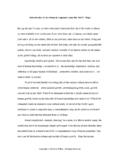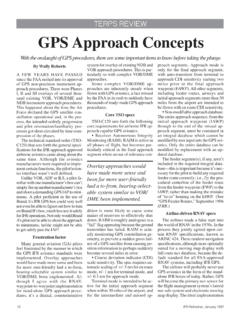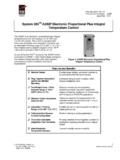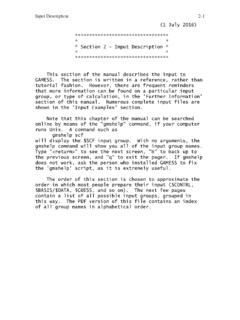Transcription of Introduction - Alain Connes
1 NONCOMMUTATIVE GEOMETRY AND PHYSICS. Alain Connes . 1. Introduction The two existing theories which successfully encode our knowledge of space-time are : General Relativity The Standard Model General relativity describes space-time as far as large scales are concerned (cf. Figure 1. and [2] for many more suggestive thoughts and pictures) and is based on the geometric paradigm discovered by Riemann. It replaces the flat (pseudo) metric of Poincar e, Einstein, and Minkowski, ds2 = dt2 + dx2 + dy 2 + dz 2. by a curved space-time metric whose components form the gravitational potential g . ds2 = g dx dx . Figure 1. Suspected black hole in center of galaxy 1. NONCOMMUTATIVE GEOMETRY AND PHYSICS 2. Figure 2. CERN collision ring The basic Einstein-Hilbert action principle given by the action Z.
2 1 . SE [ g ] = r g d4 x G M. which holds in empty space with the possible addition of a cosmological term, is re- placed in the presence of matter by the combination (1) S = SE + SSM. where SSM is the standard model action which encapsulates our knowledge of space- time at small scales as uncovered by the high energy experiments such as those per- formed at CERN (Figure 2). The transition Classical Quantum is very simple to formulate in terms of the Feynman integral which affects each classical field configuration with the probability amplitude S. ei ~. While this prescription works remarkably well for the quantization of the classical fields involved in the standard model provided one uses the technique of renormalization, NONCOMMUTATIVE GEOMETRY AND PHYSICS 3.
3 This latter perturbative technique fails dramatically when one tries to deal with the gravitational field g . In many ways this result is not surprising. Indeed many of the basic notions of the traditional formalism of Quantum Field Theory (QFT), such as particles, scattering matrices, heavily rely on the flat geometry of Minkowski space and the related Poincar e symmetry group. Treating the quantization of the g in the same way would -if successful- produce a quantum field theory of the g on Minkowski space: a strange result indeed when viewed from the geometric standpoint! The technical reason for the notorious difficulty of quantizing the g in the traditional perturbative way is the clash with either renormalizability or unitarity. In some sense this clash contains a serious warning, namely that one should not try to rush but rather meditate the lessons of both general relativity and QFT before even starting to compute something.
4 In this very short essay we shall describe a spectral . point of view on geometry which allows to start taking into account the lessons from both sides. We shall first do that for renormalization and explain in rough outline the content of our recent collaborations with Dirk Kreimer and Matilde Marcolli. As far as general relativity is concerned, since the functional integral cannot be treated in the traditional perturbative manner, it relies heavily as a sum over geometries on the chosen paradigm of geometric space. This will give us the occasion to discuss, in the light of noncommutative geometry, the issue of observables in gravity and our joint work with Ali Chamseddine on the spectral action, with a first attempt to write down a functional integral on the space of noncommutative geometries.
5 Contents 1. Introduction 1. 2. Lessons from renormalization 4. 3. Noncommutative Geometry 11. Why noncommutative spaces ? 12. A brief history of the metric system 13. Spectral Geometry 15. Inner fluctuations of the metric 19. Dimensional regularization and spaces of dimension z 20. 4. Observables in gravity and the spectral action 22. The spectral action principle 22. Functional integral 24. References 30. NONCOMMUTATIVE GEOMETRY AND PHYSICS 4. y x Figure 3. Feynman Graph 2. Lessons from renormalization In QFT the recipe of Dirac and Feynman gives the probability amplitude of a classical field configuration A as S(A). ei ~. where the classical action is the integral of the Lagrangian density Z. S (A) = L (A) d4 x One implements this recipe using perturbation theory.
6 The perturbative expansion generates integrals U ( ) labeled by Feynman graphs . It was recognized very early on (already by Oppenheimer around 1930 in trying to compute higher order effects in the Dirac theory of spontaneous and induced atomic transitions) that, as a rule, these integrals are divergent. Around 1947 and in a close interplay between experimental results (such as the Lamb shift) and theory (as developed by Schwinger, Feynman, Dyson) the technique of renor- malization was successfully applied to overcome the difficulty created by the divergen- cies. We refer to Schwinger's book on quantum electrodynamics and its Introduction for a description of the legacy of difficulties that came from the point-like nature of the electron. Already in the nineteen'th century, around 1830, Green had shown that one needs to modify Newton's law F = m a when dealing with an object moving in a fluid.
7 Thus for instance for a spherical object moving in an incompressible fluid one needs to replace NONCOMMUTATIVE GEOMETRY AND PHYSICS 5. v Figure 4. Hydrodynamics its inertial mass m by the renormalized mass m m + 12 M where M is the mass of the fluid corresponding to the volume of the ball (as in Archimedes law). While in this macroscopic case the correction 21 M is finite, the point-like nature of the electron entails that the correction m to its inertial mass due to the self-energy of the perturbation it generates in the electromagnetic field is infinite. What saves the day then is that since there is no way to extract the electron from the electromagnetic field, one only cares about the sum m + m so that the value of m (even if infinite) is irrelevant.
8 The explicit formulas which allow to concretely perform the renormalization procedure were gradually obtained by Bogoliubov, Parasiuk, Hepp and Zimmermann. They pro- vide an inductive procedure which is based on three steps. Given a graph , one first prepares , by replacing the unrenormalized value U ( ) by a sum involving suitably defined (not necessarily connected) subgraphs and the contracted graphs / . or cograph, obtained by collapsing each connected component of to a single vertex, X. R( ) = U ( ) + C( )U ( / ).. where the counterterms C( ) are defined inductively by ! X. C( ) = T (R( )) = T U ( ) + C( )U ( / ).. NONCOMMUTATIVE GEOMETRY AND PHYSICS 6. where T is the pole part in dimensional regularization. Finally the renormalized value of the graph is given by X.
9 R( ) = R( ) + C( ) = U ( ) + C( ) + C( )U ( / ).. While this procedure is perfectly justified from the physics standpoint it took a long time to uncover its precise meaning from the mathematical standpoint. This was obtained in two key steps which are (1) The Hopf algebra of Feynman graphs (2) Renormalization as Birkhoff decomposition The Hopf algebra structure hidden behind the combinatorics of Feynman graphs was discovered by D. Kreimer who first formulated the hierarchical structure of subgraphs in terms of rooted trees. In our joint work [16] we formulated the Hopf algebra directly in terms of Feynman graphs. As an algebra, the Hopf algebra H is the free commutative algebra generated by one particle irreducible (1PI) graphs. In order to define the coproduct :H H H.
10 It is enough to specify it on 1PI graphs. One sets X. = 1 + 1 + / .. where the subgraphs and the cographs / are the same as those involved in the BPHZ preparation procedure. It is a quite remarkable fact that the obtained coproduct is coassociative that it fulfills ( id) = (id ) . By construction, a commutative Hopf algebra is the algebra of coordinates on a group, and in the case of a graded connected Hopf algebra such as the Hopf algebra of graphs the corresponding group is a projective limit of unipotent Lie groups. While this shows that there are very interesting mathematical structures underlying the perturbative expansion it left open the problem of giving a conceptual understanding of the BPHZ. formulas. This problem was solved in our joint work [16].

